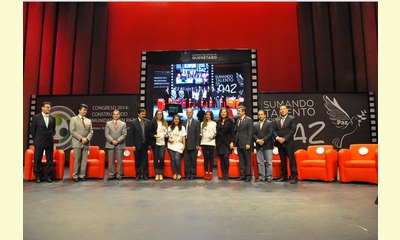|
|
Queretaro, Mexico: Congress on Building Communities in Peace
an article by Express Metropolitano, Queretaro
The Attorney General of the State, Arsenio Duran Becerra,
closed the 2014 Congress "Building Communities in Peace" by
summarizing its activities and findings. Also there was the
presentation of the awards for the State Short Film Contest
"New Talent for Peace. " 
click on photo to enlarge
At the ceremony the Deputy Prevention of Crime Victim
Assistance and Human Rights, Godofredo Alderete Velasco,
shared with attendees the following eleven conclusions of the
speakers:
1. The culture of peace is a set of values, attitudes, traditions
and behaviors based on respect for life and the end of violence.
2. Violence is not part of human nature.
3. Addressing the issue of human rights from the public
administration requires institutional recognition of the areas of
opportunity.
4. The backbone of the constitutional reform on human rights is
the principle of "pro persona".
5. Sport and culture are not only human rights but also they are
useful tools for achieving social cohesion.
6. The reform of the adversarial criminal justice system requires
a cultural change that involves, among other things: qualified,
ideological and structural training; adopting a culture of truth
and legality; and the emphasis on transparency and publicity as
practices that can show whether or not there was corruption in a
specific case.
7. From the gender perspective, the main objective for the
Mexican State before the Adversarial Criminal Justice System is
to take action to ensure access of all people to justice.
8. The role of the crime victim should be balanced with the role
of the accused in criminal proceedings.
9. Criminal investigation can reveal the facts that are necessary
and sufficient to prosecute crimes and their perpetrators
effectively and in accordance with law, provided that the public
servants involved have a thorough, accurate and precise
knowledge of human rights, criminal procedure and the means
of obtaining evidence and valuation.
10. To clarify the facts, protect the innocent, punish the guilty
and repair the damage caused to the victim are the goals that
should be pursued in the oral adversarial criminal justice
system.
11. The National Programme for Social Prevention of Violence
and Crime proposes a paradigm shift that involves moving from
a vision of public safety to a vision of citizen security, where the
conditions are generated to help enforce our human rights, and
lay the foundation for human security.
12.-All actions for social prevention should focus on specific
sectors, giving priority to groups that are vulnerable to violence
and crime.
(This article is continued in the discussionboard)
(Click here for the original Spanish version of this article)
|








|
DISCUSSION
There is no question yet associated with this article.
* * * * *
Latest reader comment:
(The following is continued from the main article listed above.)
The topics discussed during the two days of work were:
Culture of Peace: A Possible Utopia by David Adams;
Gender in the Criminal Justice System: Challenges from the Inter-American Court, by Julieta Sánchez Morales;
Benefits and Challenges of the New Criminal Justice System as outlined by Miguel Ángel López Aguilar;
Human Rights of Victims of Crime, by Luis de la Barreda Solórzano;
Public Policy and Human Rights, by Ricardo Sepúlveda Iguíniz;
Purposes of the Oral Adversarial Criminal Justice System, by Hesbert Benavente Corres;
Perspective on Human Rights in the Context of New Model of Constitutional Control, Sergio Antonio Mendez Silva;
National Program for Social Prevention of Violence and Crime, by Lucila Guerra Delgado;
Sport as an element of social cohesion, exposed by Gabriela de la Garza Tames;
Criminal Investigation in the Adversarial Criminal Justice System, Ma. Guadalupe Martínez Flores
and Reform of Culture of Peace by Hiram Valdez COMNAPAZ Chavez and specialists.
Finally, the work of the 158 films received for the "New Talent for Peace 2014" was recognized. The winners were:
first, Montserrat Escalante Gallardo, Laura Pedraza Maritza Ramirez and Elizabeth Hasby of Madrid, with "Loving differences";
Second were Santiago Sánchez Díaz and Lizeth Briseño Juárez, with "sharpener";
The third place went to Rodrigo Gómez Zea, with "Solidarity the basis of all society."
Also present in the closing were:
the Secretary of Education, Fernando de la Isla Herrera;
the Director of the Queretano Institute of Culture and Arts, Laura Corvera Galván;
President of CONMAPAZ in Mexico, Hiram Valdez Chavez;
the Legal Director of the University of Queretaro, Oscar Guerra Becerra, among others.

|
|









